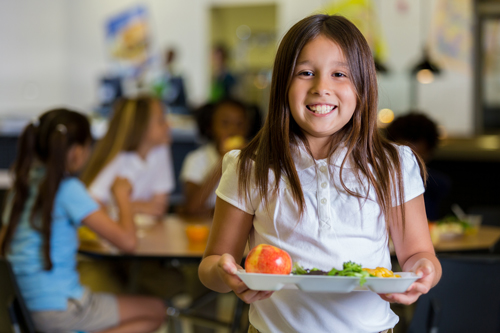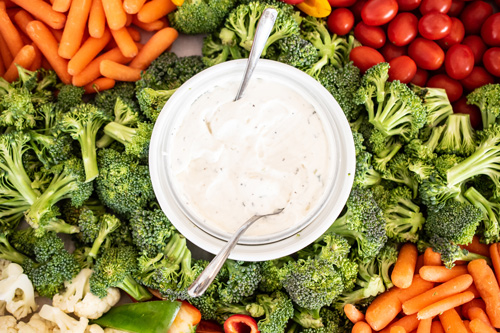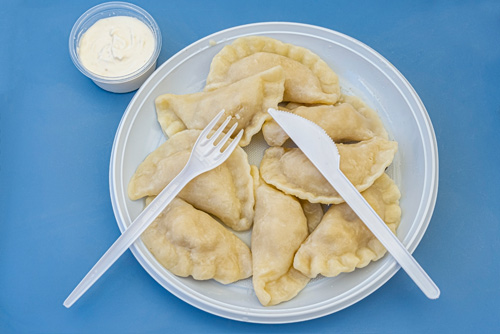
In the “before times,” our school cafeteria transformed annually into a food court full of festive flags and hand-lettered signs. At least for one evening, my three kids transformed, too, shedding their typical resistance to new foods as their classmates doled out global delicacies. They nibbled on Spanish paella and gobbled down Sudanese basta, a sweet and nutty pastry like baklava. They chased Italian meatballs with Indian mango lassis, followed by ghraybeh, a Lebanese shortbread cookie.
My middle child noticed our uninspired participation in International Night when he was in third grade. “I don't think anyone will touch this with so much other good food here,” Noah said, as I set down our contribution: a tidy platter lined with carrots, cucumbers, and cherry tomatoes and a bowl of ranch dressing.

I wasn't being lazy when I'd signed up to bring veggies and dip. I wanted to support and celebrate our suburban Connecticut community's many cultures. Yet, in the bustling café, I, too, regretted that our family wasn't on the other side of the vibrant booths. At the talent show that night, I listened to a curly-haired fifth grader sing a slow, melodious Moroccan folk song and wondered where our heritage had gone.
My grandmother Pearl fled Poland in 1934 amid mounting nationalism and antisemitism. Her father, who was blind from polio, had arrived in New York a few years earlier. With support from Governor Herbert Lehman, the Democratic Club, and Jewish charities, he operated a newsstand at 1841 Broadway. Eventually, he funded passage for his wife and five children. Pearl turned 10 years old aboard the vessel SS Kościuszko, rendering her child's fare and visa ineligible for immigration. She was detained at Ellis Island until her father returned with the money necessary to upgrade her to adult status.
Nowy Dwór and Nasielsk — the towns my grandmother grew up in — were deemed extinct after the Holocaust and are memorialized at Yad Vashem. Pearl never attended school in Poland but told me about the market her mother ran at the front of their home and the friendly dealings they had with Polish soldiers. Then, she recalled, sadly, her mother's store closed, as did the bakery, and they could no longer visit the park or attend synagogue.
Without English or any prior schooling, my grandmother was placed in a kindergarten class in New York. Embarrassed, she hurried to learn English and lose her accent. No one wore earrings like the girls had in Poland, so she took hers out and let the holes close up. My grandmother wanted to assimilate, to look and act American. Pearl met my Hungarian Czech grandfather at the 1939 New York World's Fair. After his military service, they started a family and, later, a taxi financing and insurance business, where Pearl became a dynamo (incidentally limiting her time in the kitchen).
I helped Noah list our family's countries of origin on the paper passports every student filled out that night: Poland, Hungary, Russia, and Czechoslovakia. Aside from being able to spell their names, these countries felt as foreign to me as they were to my 9-year-old.
“We're Polish, too,” I said, meeting the family donning aprons at the Poland table. We tasted pierogi and paczki (foods my grandmother had never mentioned or cooked) and kielbasa, likely not a part of our family's kosher shtetl life.

The Ashkenazic Jewish customs from that shtetl life are probably the strongest vestige of our roots. Pearl's mother, Helen, made rugelach, matzah balls, stuffed cabbage, and brisket, which my grandma later replicated for holiday dinners. These are our traditions — the foods that represent our heritage (challah, latkes, and hamantaschen, too, though I don't remember my grandmother, or my mother, ever making them).
Still, these foods feel more emblematic of our religion than the traditions of our home country. One New Jersey mother, Susan Nasberg-Abrams, solved a similar predicament at her school's International Night by adding a Jewish table, noting in her Kveller piece that “'where we are from' isn't easily represented on a map.” Separating ourselves by religion unsettles me, though, as far too reminiscent of an unsavory history. Is there a banner for us? An Ashkenazi table? Yiddish? The Israel table, while appealing, doesn't feel right either. We don't speak Hebrew, and falafel and hummus fit more with our current tastes than those of our ancestors.
Related: A Summertime Plum Cake Connects Four Generations via Jewish Food Society
My Grandma Pearl died at 96 at the start of the pandemic. My kids knew her well — her love of the stock market and card games and bright lipstick and our family, none of which fit neatly on a menu or behind a booth. The pandemic has kept our International Night on pause since 2020, but with my youngest in second grade, we have three chances ahead to find our place at the table. So much was lost in Europe during the Holocaust that it feels almost negligible to mention the loss of our ties to our homeland. Still, it's worth reminding our children of what was lost, and, thankfully, the lucky fortune of how our family — and our people — survived.
We recently started exploring “modern Eastern European fare” with dinner at a local food truck inspired by Polish, Russian and Czech influences. My kids love the pierogies with apple butter and smetana, a rich European sour cream. I was hooked from the very first bite of my chicken schnitzel in brioche with preserved cherries, horseradish cream and vegetable slaw. It tasted nothing like our traditional food, and somehow, exactly like home.
We may feel disconnected from our ancestral homeland but I know the traditions we're building with our kids as Jewish Americans are the ones they'll remember most and hopefully will carry on. They know where they're from - from holidays filled with latkes and matzoh brei to nights at the food trucks with their cousins, from challah on most Shabbats to loud and happy family gatherings that always start with crudité platters and ranch dressing.
About the Author
Jodie Sadowsky is a lawyer and freelance writer with work appearing on Kveller, Tablet, and in the New York Times. She resides with her husband and their three children in Connecticut, where they are happily engaged with their Reform congregation, Temple Sinai of Newington. Jodie also manages publicity for the emerging Jewish ritual Tzedek Box.
April 28, 2022